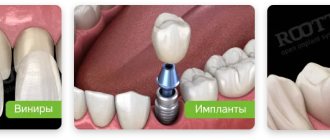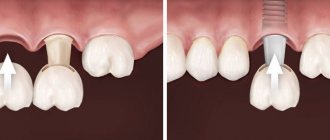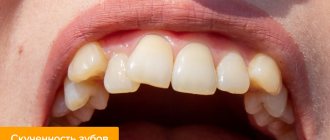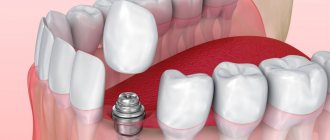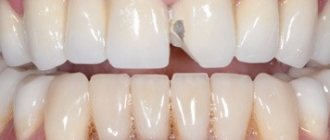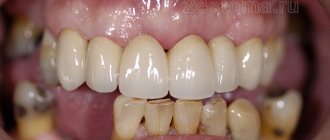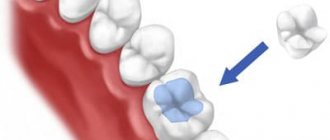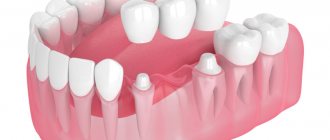This method solves the following problems:
- restoration of a severely damaged tooth;
- elimination of carious manifestations;
- changing tooth color to natural;
- filling gaps between teeth (trema and diastema);
- formation of a tooth of anatomically correct shape and size;
- aligning the position of the tooth in the dentition.
In Beskudnikovo dentistry, dental restoration is carried out at a high professional level. Experienced doctors will restore up to 70% of a lost tooth, correct its color, shape and correct the incorrect location. Thanks to the use of modern safe anesthetics, all treatment takes place without fear and pain. Modern technologies are used in diagnostics and procedures. This guarantees the strength and durability of the restoration, as well as the impeccable aesthetics of your smile.
Indications and methods for artistic dental restoration
Artistic restoration of teeth
This is a method in which the natural structure of the tooth is restored by copying dental tissues with various materials. Restoration can be carried out to change the position of teeth, to change their color and to eliminate existing defects.
Video example of restoration of anterior teeth (incisors) with composite material (eng)
Video of restoration of the upper canine with composite material (eng)
Dental restoration is a treatment whose indications are the presence of caries, any non-carious lesion of the tooth (fluorosis, enamel erosion, abrasion of the surface of the teeth, etc.), chips and cracks, gaps between teeth, enamel pigmentation, as well as incorrect positioning of teeth in dentition. At the moment, there are direct and indirect methods of dental restoration. Which method will be used depends on the problem that needs to be fixed and your wishes.
Direct dental restoration
It is performed directly in the dentist’s chair using special restoration materials. The convenience of this method lies in the fact that in one visit to the doctor you can solve your problem and enjoy a beautiful smile. However, there are cases when indirect dental restoration may be necessary; the prices for dental services in this case will be significantly higher than for direct restoration. This restoration method involves the production of thin porcelain or composite plates - veneers.
Indirect dental restoration
Now it is accepted as very high quality, since it requires making the most accurate shape of the material for your tooth in the laboratory. Due to this, such similarity with natural dental tissues is achieved.
Dental restoration techniques are used differently depending on the chosen restoration method. They differ in that with the indirect method, this technique takes place in several stages. With the indirect method, two visits to the doctor are required, taking an impression, installing a temporary filling, fitting, and only then installing the restoration material.
Our specialists will select the most suitable restoration method for your specific case and answer all questions that may arise. Teeth restoration before and after photos will show you what effect our doctors achieve.
Indications for installation of veneers
- The presence of diastemas (gaps between the front teeth);
- chips, cracks, depressions, stains on the enamel;
- discoloration of teeth as a result of medical or dental treatment;
- single teeth protruding from a row;
- small, irregularly shaped teeth;
- slightly crooked teeth;
- gummy smile.
Veneers can correct the bite in the sense that in some cases, the onlays lift the bite, thus helping to bring back the “gone” lower jaw. This prevents problems with the temporomandibular joint and improves the quality of life.
To correct malocclusion, orthodontic treatment with braces or aligners (aligners) is necessary.
What materials are used for dental restoration?
Dental restoration is the restoration of a chipped, broken or partially destroyed tooth by caries or in some other way. The materials used for dental restoration depend on which method was chosen. For direct restoration, the dentist uses composite materials (photopolymers); indirect restoration is longer and more expensive, because this method requires time to make a veneer from ceramic mass.
Dental restoration with composite materials has many adherents around the world. The development of aesthetic dentistry allows the use of the latest restoration materials, which helps patients not be embarrassed about their smile after just a couple of visits to the doctor. Photopolymers, which have found their application in the restoration process, are very convenient to work with, because they very easily take the desired shape. Composite dental restoration allows you to change the color of a tooth, restore and change its shape, and close the gaps between teeth.
Prices for dental restoration using photopolymer composite will depend mainly on the degree of damage to the tooth, the chosen treatment method and the composite material used. Dental restoration using filling material is in many ways inferior to restoration using veneers. Over time, this material may darken, lose its shine, and if the tooth is severely damaged, such a restoration can be destroyed under the influence of external factors.
Sequence of the dental restoration process
There is a certain sequence in which the restoration procedure is carried out. This methodology must not be violated, otherwise you will not get the desired result. So, the stages of dental restoration:
- Preparation for the restoration procedure. The tooth surface is mechanically cleaned, anesthesia is applied if necessary, and the tooth is isolated from saliva using a rubber dam.
- Tooth preparation. Removing pigmented enamel, softened dentin and cleaning teeth from caries.
- Gasket application. It is necessary to protect the pulp from possible exposure to the composite.
- Etching dentin and enamel. It is necessary for the sterility of the surface of the cavity and promotes better adhesion of the hard tissues of the tooth to the composite.
- Applying primer to the surfaces of enamel and dentin. Makes dentin airtight, thereby limiting it from any external influences due to clogging of dentinal tubules.
- Application of composite and its plastic modeling.
- Composite polymerization. Hardening of the composite material.
- Final processing of the restoration. The surface is modeled and formed after restoration.
- Carrying out control tests and correction of restoration work.
- Surface polishing.
- Final polymerization.
What is better – correcting crooked teeth with veneers or braces?
Comparing these treatment approaches is difficult. Braces correct malocclusions, and veneers mask defects.
| Veneers | Braces | Aligners (aligners) | |
| Tooth preparation | The enamel is removed to a depth of 0.2-0.7 mm | Not carried out | Not carried out |
| Duration of treatment | Up to 2 weeks | Up to 2 years | Up to 3 years |
| Severity of defect | Lightweight | Deep | Deep |
| Diet changes | For 2-3 days | Yes, all the time of treatment | No |
| Care | No special care required, just be careful when using it | Careful hygiene required | Careful hygiene required |
When they say that veneers correct the bite, they mean the aesthetic aspect. Braces and aligners eliminate deep violations.
Alternative restoration
Restoration of the tooth crown
Can be produced in various ways. Our clinic offers them all. This can be traditional dental filling, covering the tooth surface with veneers, restoring the anatomical shape of the tooth using a crown, or any existing method of prosthetics (implants, inlays, etc.). The main task of the dentist is to choose and offer the patient the most optimal method of tooth restoration.
Dental restoration with veneers
This method will be acceptable in the following cases:
- treatment of chipped teeth;
- getting rid of a small gap between the front teeth;
- changes in enamel color that cannot be bleached in any other way;
- changes in the shape of the tooth crown;
- changes in moderate curvature of teeth.
Dental restoration with inlays
It is used for minor tooth damage, when restoration of 1-2 sides is necessary. There are restorative (restore the shape and color of the tooth) and stump (a crown is then placed on top of them) inlays. Inlays can be made of metal, ceramics, metal-ceramics, as well as composite and all-ceramic.
If your tooth is more than half destroyed, and even more so if the nerve in it has also been removed, then it is recommended to install a crown. They are ceramic and metal-ceramic. Service life, aesthetics and reliability are superior to conventional restoration methods.
Disadvantages of restorations –
- Restorations darken and lose their shine over time - fillings and restorations made from light-polymer filling materials tend to gradually darken. In addition, they lose the shine characteristic of healthy tooth enamel. If the loss of aesthetics on chewing teeth is not so terrible, then on the front teeth it is very unpleasant. Not very good restorations will have to be replaced every few years, but high-quality restorations should require periodic care (you need to visit the dentist once a year to polish them) - then their aesthetics will last longer.
- Risk of breakage of restorations - if your tooth is destroyed by more than 1/2, and especially if it is also depulped (nerve removed), and you still want to chew meat, then there is a risk of breakage of the restoration.
Depulped teeth are much more fragile than living ones. Particularly often, restored teeth break when the tooth is restored completely from the root. If the chewing load suddenly exceeds the strength limit of the restored structure, the restored part of the tooth breaks off. Sometimes this even causes a fracture of the tooth root (with the need for its subsequent complete removal). What is the best way to restore a tooth if it is destroyed by more than 1/2 - this is where indirect aesthetic restorations will help us, because ceramic crowns, veneers, etc.
Contraindications for dental restoration procedures
- The patient has an incorrect bite.
- Absence of a certain number of chewing teeth.
- The presence of a disease - bruxism.
- Monolithic destruction of the inner enamel of the tooth.
- Unnatural tooth wear.
- Passion for dangerous sports (for example, boxing).
However, some indications can be treated, so the possibility of restoration should not be abandoned forever. You can cope with bruxism or correct a malocclusion and then contact us for dental restoration.
Why is tooth stump restoration necessary?
Tooth stump restoration is used in dentistry to restore a badly damaged tooth to a degree that allows the tooth to be prepared for installation of an artificial crown. Recently, dentists have been actively using the direct method of restoring the tooth stump (pinless method), which uses special composite materials. Very often, when a tooth is severely damaged, only the root remains and for greater support, it is necessary to install a pin (pin method). The mouth of the canal is widened, treated, filled, and only after that can a pin be installed.
There is also another way to restore a tooth stump - a cast stump inlay. This is a custom made metal post that restores the portion of the tooth above the gum. This is a monolithic alloy that has no seams or joints, which gives it greater strength and resistance to heavy loads.
Contraindications to the procedure
Fortunately, there are not many of them. An absolute contraindication is an allergic reaction to composite materials.
Relative contraindications:
- some types of malocclusions;
- bruxism (grinding teeth during sleep);
- patient's failure to comply with oral hygiene;
Light-curing materials should be used with caution if the patient has a pacemaker.
Using the direct method of restoring teeth is difficult if it is impossible to protect the restoration site from moisture.
Artistic restoration of anterior teeth
Dental restoration in Moscow today is available to everyone, and it is especially important for that part of the teeth that we show to others. Artistic restoration of the front teeth requires good skills from the dentist not only from a medical, but also from an aesthetic point of view. This type of restoration is the most popular because people want to smile without embarrassment. Restoration of the anterior group of teeth by specialists at our clinic today is able to correct any tooth defects from chips and cracks to giving the natural color of tooth enamel.
There are direct and indirect restoration of anterior teeth. Only consultation with a specialist can help you choose one of these methods. In the first case, reflective filling materials are used. This process is based on layer-by-layer application of photopolymer material, which requires the skill and experience of a doctor. This method can be used for minor damage to the tooth, as it is subject to abrasion over time. Restoration of the frontal group of teeth, when choosing an indirect method, is based on the work of the doctor, which consists of observing several rules:
- correct selection of the color of the desired material for the veneer;
- using the correct tooth preparation technique;
- taking impressions of the front teeth;
- installation of temporary and then permanent veneer.
Restoring the front teeth with veneers will be appropriate if, after some dental procedures, it is no longer possible to achieve color by whitening. They can also be used to slightly correct the shape of your teeth. Depending on the manufacturing method and material, veneers are divided into therapeutic ones made of composite material and orthopedic ones made of ceramics. Only a qualified dentist can tell you which type you need. The effect obtained from this method of restoration can be seen in the photo before and after restoring teeth with veneers.
Few people think about the fact that when we talk or laugh, the lower part of the teeth is always visible. Therefore, restoration of the lower teeth is extremely important and simply necessary for a healthy and beautiful smile. Also, a very large load is placed on the lower row of chewing teeth, which contributes to the frequent formation of chips and caries. Therefore, you need to understand that artistic restoration of chewing teeth is important not only from a practical, but also from an aesthetic point of view.
Aesthetic restoration of the front teeth from below and above is necessary, first of all, for people who have problems with their teeth, but want to be self-confident and not be afraid of communicating with other people.
Restoration of chewing teeth –
In videos 3 and 4 you can see how the restoration of chewing teeth is carried out with composite filling material. In video 3, the restoration can hardly be called “artistic”, because... The chewing surface of the tooth with all its fissures was restored only “satisfactorily”. However, this video does a good job of showing the restoration of the side walls of the tooth and the contact points between the teeth. Video 4 shows the final stage of a truly artistic restoration.
Restoration of the chewing group of teeth
The main goal pursued during the restoration of lateral teeth is the restoration of their functionality, that is, the restoration of chewing function. Restoration of lateral crooked teeth is necessary for several reasons.
Firstly, excessive curvature of the teeth can tear the gums, thereby causing discomfort and pain when eating.
Secondly, an incorrect bite can lead to incorrect redistribution of the load on the teeth.
Third, wide and flat surfaces will cause severe tooth wear and reduce chewing efficiency.
All these factors can negatively affect the general condition of all teeth. Therefore, during restoration, reproduction of the individual characteristics of the tooth, including macrorelief, all tubercles and pits, plays a very important role. You should monitor the health of all teeth without exception, not paying attention only to those that are visible when you smile.
When is it better to refuse to correct your bite with veneers?
Like any intervention, veneering has limitations. The pads are not suitable for people suffering from bruxism. Grinding your teeth can ruin all your work. You should not install pads if you have the following pathologies in adults:
- periodontitis 3-4 degrees (teeth are very loose, gums are inflamed);
- thinning of enamel;
- significant damage to the crown (from 40%);
- lack of teeth in the area of prosthetics;
- severe curvature.
Sometimes it is possible to place veneers on crooked teeth after the condition improves or certain conditions are met. So, in case of infections, pregnancy, childhood, you just have to wait.
Restoration of baby teeth in children
Today, even a child can have a tooth restored in our clinic. Restoration of a baby tooth is necessary in case of injury or extensive carious destruction. This method allows you to completely restore the anatomy of the crown of a baby tooth, which will allow you to preserve it until it is naturally removed and replaced with a permanent tooth. Do you think saving a baby tooth makes no sense?
You are wrong, because the health and well-being of baby teeth has a direct impact on the condition of permanent teeth. Plus, a baby tooth that falls out unnaturally can cause deformation of the dentition. After all, if the permanent tooth has not pushed it out, but the gums are empty and the neighboring teeth may begin to move. In addition, premature tooth loss can lead to deterioration of diction, changes in bite, increased load on neighboring teeth, which can also fall out prematurely and many other negative consequences. Thus, we come to the conclusion that the need for restoration of temporary teeth should not be ignored by parents. Timely intervention by a dentist in the problem will help avoid complications in the future.
Indications for restoration in case of crooked teeth
Defects of the anterior crowns can be either congenital or acquired during life. The patient usually decides for himself to what extent the aesthetic defect of the tooth requires restoration. If the defect is very pronounced and brings a lot of discomfort, then the restoration procedure with new material becomes necessary in the following cases:
- The presence of crooked dental crowns that put pressure on neighboring teeth.
- Significant deviation of the location of the dental unit from the norm.
- Pathological lengthening (expansion or narrowing) of the tooth crown.
- Formation of a gap due to an unevenly positioned crown.
Sometimes patients ignore the aesthetic imperfections of their teeth. However, they do not take into account that curvature can significantly affect the bite and damage not only the antagonist tooth, but also disrupt the movement of the entire jaw when chewing. In other cases, the curvature leads to frequent biting of the cheek or tongue, which is also not normal. It is advisable to examine these points with an orthodontist and make sure that the incisor defects do not interfere with the rest of the oral cavity and do not require urgent restoration.
All methods of restoration of crooked teeth are divided into direct and indirect. The direct method is a restoration in which the crown is installed and formed with plastic material directly on the tooth. The second category includes prosthetic methods that involve creating and shaping a section of a tooth separately, according to prepared casts or 3D models of the tooth being restored. Let's look at each of the restoration options, their advantages and limitations.
Aesthetics in dentistry
In our society, a beautiful snow-white smile has already become not just a sign of health and well-being, it is good manners. That is why cosmetic dental restoration in Moscow is now so popular. Now it is customary to sparkle with the whiteness of your perfectly straight teeth and even decorate them with precious stones.
Aesthetic dental restoration involves giving the ideal appearance of the tooth, its color, shape and structure. In the hands of a professional dentist, restorative materials transform teeth into works of art. Since modern aesthetic restoration implies the complete elimination of any changes and defects on the surface of the tooth. This is exactly the kind of modern dental restoration on Vernadsky Avenue (Yugo-Zapadnaya metro station) that is available to everyone. Our clinic’s specialists will advise you and tell you what types and how restoration of tooth color, enamel and shape occurs. They will advise you on prices and explain what results you should expect from each specific restoration method.
In order to achieve a beautiful shape and durable dental covering, our dentistry uses high-quality composite materials. These materials come in a huge variety of colors to give the teeth a natural appearance and similarity to the patient's other teeth. Restoring the shape of teeth allows them to return their functionality, as well as make the size of the teeth more suitable to each other from an aesthetic point of view.
Aesthetic restoration of anterior teeth is designed to give a natural shape to the tooth line. It is known that teeth darken with age, and teeth with a removed nerve also have this unpleasant property. The color of enamel is negatively affected by eating foods that have coloring properties, as well as smoking. In modern dentistry, there are many teeth whitening systems. Restoration of tooth enamel can be carried out using any of them or by applying special lumineers and veneers.
You can contact our clinic and get all the information you are interested in about how artistic dental restoration works. Our prices are quite reasonable, and the quality of the services provided makes you come back to us again and again.
Aesthetic dental restoration video shows how the procedure takes place in the clinic.
How much does it cost to fix crooked teeth?
If you want to know what to do about crooked teeth, the first step is to consult a qualified orthodontist. He will determine which method is best to use and install a corrective system.
Modern dentistry offers a wide range of systems for correcting crooked teeth and malocclusion. They all vary in cost. It is important to choose not only a correction method that is suitable for the price, but also to contact qualified specialists.
There are not so many orthodontists with the required qualifications (as well as dentists of other specializations), but at the 32 Dent clinic there are specialists who install braces, veneers and other bite correction systems for adults and children. It’s also nice that the clinic has fairly affordable prices, so almost all patients can correct their crooked teeth.
The best material for teeth is ceramics
Ceramics have been used in dentistry for many years and are very successful. Dental restoration with ceramics is the best way to achieve an invisible and high-quality result. Dental restoration of teeth requires not only the correction of teeth from an aesthetic point of view, but also the elimination of more serious defects. Crowns, veneers, lumineers, bridges, etc. are made from this material.
Lumineers are made from high-strength pressed ceramic. They are resistant to mechanical damage, look very natural and are durable. This is an ideal replacement for regular teeth whitening.
Ceramics also have another very important quality - a wide range of colors. Choosing the right color is not difficult, since the choice is large, you can find all natural shades of teeth.
Now you have access to high-quality ceramic dental restoration at Yugo-Zapadnaya. To do this, you must come to us, here you will be pleased not only with the quality of the services provided and the professionalism of the staff, but also with the cost. Tooth restoration in Moscow at the ARTOX clinic is fast, high-quality and inexpensive .
Our specialists know first-hand what dental restoration is. You can find reviews about all restoration methods on the Internet, but you should not completely trust them. Only professional diagnostics and consultation with a doctor, a specialist in this field of dentistry, can provide you with a complete picture of the treatment and tell you how justified a particular restoration method is. The main thing is to be sure who you trust with your health.
And don't forget that regular visits to the dentist and good oral hygiene will help you prevent many dental problems. Well, if they do arise, then you must immediately seek qualified medical help in order to avoid complications. Our clinic is always ready to come to your rescue and provide quality treatment at affordable prices.
Pros and cons of veneering
Dental overlays for correcting malocclusion not only make your smile attractive, they increase self-esteem and improve your psychological state.
Advantages of veneers:
- Short installation times
. Composite onlays require 1 appointment, and ceramic onlays require 2-3. - Exact imitation of enamel
. The ability to transmit light makes ceramics indistinguishable from natural teeth - Biological inertia
. Allergy is not a contraindication. - Resistant to pigments and dyes
. Unlike natural teeth, ceramics do not change color over time. - Durability
. Ceramic compounds are several times stronger than composite ones. - Wear resistance
. If the recommendations are followed, ceramic linings last up to 20-25 years. Plates are replaced more often because the cement (adhesive) that attaches them to the teeth wears out.
97%
[1] Veneers are functioning perfectly 7 years after installation.
83%
[2] – after 20 years.
Several factors influence the lifespan of veneers:
- doctor's qualifications;
- mastery of technique;
- compliance with manufacturing and fixation technology;
- quality of materials;
- patient compliance with recommendations.
Therefore, it is recommended to choose large clinics with their own dental laboratories. The dentist and technician work together in such centers, discuss problems and find the best ways to solve them. The third member of the team is the patient.
It must be remembered that no veneer, even the most durable, can resist cracking nuts or biting wire. But curvature can be corrected with plates in a high-quality and long-term manner only if the recommendations are followed.
Disadvantages of veneers:
- The need for tooth preparation. Once you install veneers, you won’t be able to refuse them.
- High price. However, in the long term, ceramic veneers pay off. They do not need to be regularly polished and replaced with new ones.
